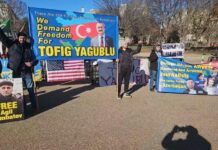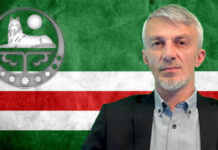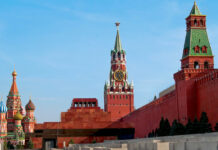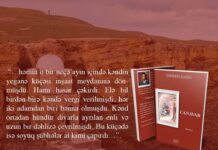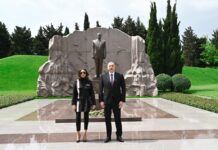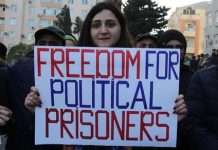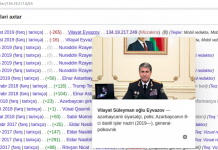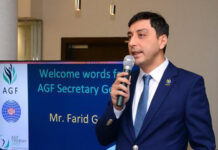The start of Azerbaijan’s operation to liberate the territories occupied by Armenia has increased again the interest in the region and the Karabakh conflict in the world. The world press, experts, governments discuss various aspects of this conflict, including its historical aspect. The main initiator of the historical aspect of the Karabakh conflict is Armenia, which wants to lay the foundation for legal and political insinuations with a false historical justification “Nagorno Karabakh has never been a part of independent Azerbaijan”.
Turan has already published an interview with Professor Jamil Hasanli, the chair of the National Council of Democratic Forces, about the history of the entry of the Karabakh Khanate, as an Azerbaijani state entity, into the Russian Empire in the early 19th century. Because of the continuing interest in the historical view of the problem, Turan continued the conversation with Professor Hasanli.
– Jamil muallim, how do you assess the latest situation around Nagorno-Karabakh?
 – The Geneva meeting ended on the evening of October 31. The co-chairs of the Minsk Group, which had not been able to do serious work to resolve the problem for 30 years, issued another statement. The talks focused on approving the statements made in Moscow, Paris, and Washington, achieving a humanitarian ceasefire, calling for non-shooting of humanitarian facilities, guaranteeing the safe operation of the International Committee of the Red Cross and the Personal Representative of the OSCE Chairman-in-Office, and other issues. But the point is that every time a humanitarian ceasefire was declared, peaceful settlements, large cities and regions of Azerbaijan, such as Ganja, Tartar, Barda, have come under fire, and prohibited cluster munitions and long-range missiles have been used against civilians. This is confirmed by an international human rights organization such as Human Rights Watch. The number of civilians killed during the military operations in the non-conflict zones of Azerbaijan, including childrens, women, and the elderly, is approaching 100 people. The leaders of the Armenian armed forces do not hide the fact that they hit settlements not included in the zone of military operations in Azerbaijan. There are even reports of rocket fire into the cities and districts from Armenia. The point is that the Armenian military units in the occupied territories of Azerbaijan are not connected to a single command. On the one hand, the Armenian army, on the second hand, the “self-defense groups” of the Artsakh toy organization, on the third hand, the rebellious groups of veterans of the First Karabakh War and, finally, Armenian “volunteers” and PKK militants from abroad, mainly Syria and Lebanon, are fighting here. In such circumstances, it does not seem convincing that the Armenian side will abide by the ceasefire. Just as we saw during the previous ceasefires.
– The Geneva meeting ended on the evening of October 31. The co-chairs of the Minsk Group, which had not been able to do serious work to resolve the problem for 30 years, issued another statement. The talks focused on approving the statements made in Moscow, Paris, and Washington, achieving a humanitarian ceasefire, calling for non-shooting of humanitarian facilities, guaranteeing the safe operation of the International Committee of the Red Cross and the Personal Representative of the OSCE Chairman-in-Office, and other issues. But the point is that every time a humanitarian ceasefire was declared, peaceful settlements, large cities and regions of Azerbaijan, such as Ganja, Tartar, Barda, have come under fire, and prohibited cluster munitions and long-range missiles have been used against civilians. This is confirmed by an international human rights organization such as Human Rights Watch. The number of civilians killed during the military operations in the non-conflict zones of Azerbaijan, including childrens, women, and the elderly, is approaching 100 people. The leaders of the Armenian armed forces do not hide the fact that they hit settlements not included in the zone of military operations in Azerbaijan. There are even reports of rocket fire into the cities and districts from Armenia. The point is that the Armenian military units in the occupied territories of Azerbaijan are not connected to a single command. On the one hand, the Armenian army, on the second hand, the “self-defense groups” of the Artsakh toy organization, on the third hand, the rebellious groups of veterans of the First Karabakh War and, finally, Armenian “volunteers” and PKK militants from abroad, mainly Syria and Lebanon, are fighting here. In such circumstances, it does not seem convincing that the Armenian side will abide by the ceasefire. Just as we saw during the previous ceasefires.
– In recent days, the USA’s nerves are shot regarding Karabakh. What is this about?
– Of course, this is primarily due to the approaching presidential election, the struggle of candidates for the votes of Armenians. However, separate speeches cannot be taken as the position of the United States. The United States has officially stated its position. This position is to resolve the conflict within the framework of Azerbaijan’s territorial integrity and sovereignty. The leadership of the Federal Republic of Germany has taken the same position. Even Putin, who is seen by various Armenian forces as the last resort, has acknowledged that the seven regions, which have been under occupation for nearly 30 years, have nothing to do with the conflict. When these positions were stated, the issue of “self-determination”, which Armenians have long referred to, was not even mentioned. Because the territorial integrity of states has always prevailed over the principle of “self-determination” in the known UN charter. This has recently been reaffirmed. In fact, the nonsense and fabricated ideas made by Armenians over the past few weeks, such as “separation for the sake of salvation” and “Nagorno-Karabakh has never been part of independent Azerbaijan”, are due to the international failure of the long-speculated principle of “self-determination”.
Even these days, “The Economist” going further, wrote that “Lenin assigned the predominantly Armenian Nagorno-Karabakh to Soviet Azerbaijan a century ago, as a prize for securing control over its oilfields, and in the hope of installing a red beacon in the Muslim world”. They still can’t clarify that the Nagorno-Karabakh region was ” given away” to Azerbaijan, Lenin or Stalin. Unfortunately, the problem is that people are busy with work they don’t know, how can such an absurd idea be reflected on the page of an influential magazine like “The Economist”?
– From a historical point of view, is the claim that “Nagorno-Karabakh has never been part of independent Azerbaijan” based on any document or fact?
– This is a fabrication, and because it is a fabrication, it cannot be based on any document or fact. First of all, let’s say that historically, there has never been a territorial unit called Nagorno-Karabakh. Both the mountain and the lowland of Karabakh are a geographical place. The term “Nagorno-Karabakh” was brought to Azerbaijan by the Russian Bolsheviks in the 1920s. In fact, this nonsense is not new. Robert Kocharyan and Serzh Sargsyan came up with this idea in time to prepare the ideological basis for their acts of aggression. Now Pashinyan is clinging to that idea as a way out of the situation after a serious failure on the battlefield. With regard to the current situation in Nagorno-Karabakh, this idea seems a bit attractive to foreign forces that want to “save” the Armenians. But it has no historical basis, it is a fabrication, a fantasy. Historically, there has been no Karabakh, no mountains and no lowlands outside Azerbaijan. In fact, three years ago, Armenians abandoned the name “Nagorno-Karabakh” and clung to the term “Artsakh” because they did not see themselves in the past of Karabakh. Therefore, they are interested in removing the issue from the historical plane and politicizing it.
– What does real history say?
– When we refer to real history, when the stones are placed in their places neatly, a completely different picture emerges. The modern geopolitical landscape in the South Caucasus has been shaped over the last three centuries. There was an independent Karabakh Khanate, which was established in the middle of the 18th century, and the whole territory of Karabakh was considered to be the geography of that khanate. The absolute majority of the 130,000 people living in the territory of the khanate were Muslim Turks. The 5 Christian melikdoms, each consisting of 3-4 villages, had no power or influence in the life of the khanate. There are two key documents regarding the past of Karabakh, and these documents are very important from a historical point of view in terms of who owns Karabakh. The first was the Kurakchay Treaty signed between the Karabakh Khanate and the Russian Empire on May 14, 1805, and the second was the decree of the emperor Alexander I dated September 10, 1806, on the appointment of Mehdugulu agha, son of Ibrahimkhalil khan, as the ruler of Karabakh in place of Ibrahimkhalil khan, who was killed as a result of a “misunderstanding”. These basic documents do not give the least sign of the presence of the Armenian factor in Karabakh.
– In this case, it becomes clear that the Armenian claim that “Nagorno-Karabakh has never been part of independent Azerbaijan” has nothing to do with history.
– You know, Armenians have separated their history, as well as the past of the region, from the historical realities and adapted it to their interests. They cannot reveal a single fact or a single historical document. They also avoid historical discussion. Knyaz Golitsyn, once the Supreme Commander-in-Chief of the Caucasus, reported to Tsar Nicholas II in 1900 that when Russia conquered the Caucasus, a total of 45,000 Armenians lived there, and now their number has reached one and a half million. After all, we do not fabricate it ourselves. This report is in the Russian Military History Archive in Moscow. Let them go and see. Furthermore, Tsarist Russia took a census in the former khanates after the occupation of the South Caucasus. In 1823, a similar census was carried out in the territory of the Karabakh Khanate, which had already been abolished, and the results were published in Tbilisi (Georgia) in 1866 (“Description of the Karabakh province prepared in 1823 according to the order of the governor in Georgia Yermolov by state advisor Mogilevsky and colonel Yermolov 2nd, Tbilisi, 1866.” – Russian: “Описание Карабахской провинции, составленное в 1823 г. действительным статским советником Могилевским и полковником Ермоловым 2-ым, Тифлис, 1866.”). It was a perfect set to determine the ethnicity of the population, the names of the settlements, and the religious beliefs of the people. In general, when registering the population in the occupied territories in the early 19th century, Russian administrations registered Armenians in two separate groups unlike Muslims. The first group was called old residents (Russian: старожильцы), and the second group was called newcomers (Russian: новопришельцы). Due to these newcomers, the ethnic landscape in the territory of the former Nakhchivan, Iravan (Yerevan), and Karabakh Khanates gradually changed and reached the point that Knyaz Golitsyn said.
– After the abolition of the Karabakh Khanate, the Azerbaijan Democratic Republic was established in May 1918, and this independent state existed for two years. What was the administrative subordination of Karabakh and its mountainous part at that time?
– This is a question that Armenians want to pass over in silence. Shortly after the establishment of the Republic of Azerbaijan, Baku was liberated and Azerbaijan’s sovereignty was ensured in an area of 98,000 square kilometers, including Karabakh. Shortly after the Allied troops entered Baku in November 1918, the British command recognized that Karabakh and Zangazur was under the control of the Azerbaijani government. Namely, in January 1919, at the suggestion of the government, General William Thomson appointed Khosrovpasha bey Sultanov Governor-General of Karabakh and Zangazur. He had an Azerbaijani and an Armenian assistant. However, the Armenians wanted to seize Azerbaijani territories, using the entry of the allies into Baku as a moment of revenge. After getting acquainted with the situation, in the first days of December 1918, General Thomson sent a telegram to the leaders of the Armenians living in Ganja, Gazakh, and Javanshir districts, demanding that the Armenians put an end to lawlessness and robbery in these areas. He said: “All Armenians should be informed to sit quietly in their homes. If they do not carry out this order, they will have to account directly for the bloodshed and lawlessness.” Shortly afterwards, after the expulsion of nationalist elements, who were sent from Armenia, from Karabakh, in July-August 1919, the Armenian peasants of the mountainous part of Karabakh adopted resolutions on recognizing the government of Azerbaijan and obeying its laws at their congresses. Even the Bolsheviks of Russian, Armenian, and Jewish origin admitted that during the Democratic Republic, the mountainous part of Karabakh was always part of the Musavat government of Azerbaijan. Shortly after the sovietization, Narimanov, Mdivani, Mikoyan, Naneyshvili, Vesnik, Levandovsky, and Mikhailov wrote in a letter to Moscow on July 10, 1920, stating that “during the Musavat government, Karabakh was entirely part of Azerbaijan. The unbreakable economic and cultural unity of Karabakh and Zangazur with Baku stems from the tens of thousands of workers from these provinces, and the fact that they have no connection with Iravan (Yerevan) is a historical fact of the recent past.” Both in Armenia and abroad, those who say “Nagorno-Karabakh has never been part of independent Azerbaijan” should get acquainted with these documents.
– In recent writings and speeches, the opinions about Stalin’s alleged transfer of the mountainous part of Karabakh from Armenia to Azerbaijan are brought back to the agenda.
– There is no historical basis for this. This claim is not confirmed by archival documents of the period. The “Stalin thesis” was fabricated by Armenian scientists and politicians in the late 1980s, when Yerevan’s claims about Nagorno-Karabakh arose. At that time, a commission was established under the chairmanship of Alexander Yakovlev, the ideological secretary of the Soviet Communist Party. The commission re-examined the Stalin era, revealed new facts about his illegal actions, especially regarding repression. That is why the Armenians came up with the idea to present Nagorno-Karabakh as a “victim” of Stalin’s repressions. When the events began, they sent a 400-page reference to Moscow, which was based entirely on a fabricated “Stalin’s thesis”. I have studied this issue in detail. I have read in detail the materials of the plenum of the Caucasus Bureau held on July 4-5, 1921, and the protocols kept in the archives of Baku, Tbilisi, and Moscow. I can say with full confidence that the idea that Stalin allegedly took the mountainous part of Karabakh from Armenia and gave it to Azerbaijan is a complete lie and fabrication. There is nothing in the documents to reflect this. None of the Armenian communists who took part in that plenum said a word or wrote a line about it anywhere.
– But what really happened?
– In fact, none of the foreign researchers who have been talking about “Stalin’s fabrication” in recent days has seen the Protocols No. 11 and 12 of the plenums of the Caucasus Bureau held on July 4-5, 1921. They are repeating this lie invented by Armenians 30-35 years ago in accordance with the political situation. For example, they write that at a meeting chaired by Stalin, Nagorno-Karabakh was taken from Armenia and given to Azerbaijan. After all, Stalin was not a member of the Caucasus Bureau, he did not have the right to vote in the Plenum or to make proposals, how could he lead a meeting of an organization although he was not a member. The plenum was chaired by Sergo Ordzhonikidze. After Nakhchivan was recognized as an Azerbaijani protectorate under the Moscow Treaty signed between Russia and Turkey on the eve of the plenum, Armenians began to protest against Soviet Russia. To “compensate” for this dissatisfaction, Moscow secretly instructed the leadership of the Caucasus Bureau to prepare for the transfer of the mountainous part of Karabakh to Armenia. Even the Commissariat of Foreign Affairs of Soviet Russia wrote in its annual report for 1921 that this work had already been completed, and in December of that year, the mountainous part of Karabakh was handed over to Armenia. Because the instructions were like that. However, the heads of the Caucasus Bureau, including Sergo Ordzhonikidze, repeatedly wrote to Moscow that the mountainous part of Karabakh is an integral part of Azerbaijan. In accordance with the above-mentioned instructions, on July 4, the plenum put the Nagorno-Karabakh issue to a vote as the 5th issue and decided to transfer it to Armenia. However, Narimanov’s statement was announced as the 6th issue at the same meeting of the plenum on the same day and at the same hour. Narimanov said that given the importance of the Nagorno-Karabakh issue for Azerbaijan, the issue should be discussed by the Central Committee of the Russian Communist Party. The members of the plenum voted for Narimanov’s statement, which was adopted, and thus the 5th issue lost its legal force. But Ordzhonikidze, the Bolshevik “Caucasian villain”, did not agree to hold the discussion in Moscow. Therefore, the next day, on July 5, at the suggestion of him and Amayak Nazaretyan, the issue was raised again and a decision was made to KEEP (not transfer, not return, but keep) the mountainous part of Karabakh as part of Azerbaijan and give it the status of an autonomous oblast. In fact, it was the idea of the Bolsheviks to give the mountainous part of Karabakh the status of an autonomous oblast. On July 2, 1920, in response to a coded telegram from People’s Commissar for Foreign Affairs of the Soviet Union, Georgy Chicherin, declaring Karabakh and Zangazur a disputed territory and then giving them to Armenia, Ordzhonikidze wrote: “In my opinion, Karabakh and Zangazur should remain in Azerbaijan,” and added: “I will force Azerbaijan to declare the autonomy of these regions. However, this idea must come from Azerbaijan, and in no case can it be specified in the agreement” (the agreement between Armenia and Soviet Russia). He secretly reminded Lenin, Stalin, and Chicherin that, “we could declare autonomy here (in Karabakh) and organize the Armenian population without allowing Muslim troops there.” That’s what happened. With this step, the Bolsheviks laid a landmine, which Azerbaijan still suffers from, on the foundation of the Azerbaijani statehood.
– In this case, we want to know: why did Stalin come to Tbilisi in general?
– At that time, Stalin was resting in Nalchik. His sudden visit to Tbilisi (Georgia) was not related to the discussion of the Nagorno-Karabakh conflict. Moscow was dissatisfied with the chairman of the Georgian Revolutionary Committee, Filipp Makharadze, who was trying to become more independent. Hence, Stalin came to Tbilisi (Georgia) to replace him with the more obedient Budu Mdivani. As soon as the plenum of the Caucasus Bureau ended, on July 7, this issue was brought to the attention of the Central Committee of the Communist Party of Georgia, and the change was implemented. In other words, Stalin’s “sudden” visit to Tbilisi had nothing to do with the Nagorno-Karabakh conflict.
– Did they ever return to this issue later?
– Yes, later in the Soviet era, two more initiatives on the unification of Nagorno-Karabakh with the Armenian SSR were taken by the leadership of Yerevan: in September 1945 and in September 1966. Both failed. In July 1945, since the Politburo of the Central Committee of the Soviet Communist Party secretly decided to organize a separatist movement in South Azerbaijan and planned to unite it with Soviet Azerbaijan in the future, First Secretary of the Communist Party of Armenian SSR, Grigory Arutyunov, appealed to Moscow to unite the Nagorno-Karabakh Autonomous Oblast (NKAO) with Armenia. This appeal was sent to Mir Jafar Baghirov by Malenkov in November of that year to get acquainted and express his opinion. At that time, Baghirov collected all the documents related to Karabakh to prepare a response. These documents, which included two volumes, are still kept in the Archive of Political Documents. Baghirov wrote to Moscow that he did not consider it expedient to change the borders between Armenia and Azerbaijan. According to him, if Moscow insisted on this issue, Nagorno-Karabakh, with the exception of Shusha, could be transferred to Armenia, with the transfer of Azizbayov, Vedi, and Garabaghlar districts of the Armenian SSR, which consisted mainly of Azerbaijanis, to the Azerbaijani SSR. However, the Armenians did not agree. Baghirov also added that if the change of borders between the republics was discussed, the issue of returning Gasimkend and Maharramkend regions of the Dagestan Autonomous Soviet Socialist Republic, which had long been part of Azerbaijan, to Azerbaijan should be considered. Armenians became active again in the 1960s. Especially in the late 1950s and 1960s, in secret meetings between the leaders of foreign Armenian parties, who visited the Soviet Union under fake passports and fake names, and the Soviet special services (KGB) and the Soviet Communist Party, they raised the issue of handing over NKAO to Armenia. In early December 1960, the Azerbaijani leadership received an interesting letter from Moscow. There was an appeal to the “President of Soviet Azerbaijan” attached to the letter of the Central Committee of the Communist Party of the Soviet Union (CCCPSU). The appeal was published in the Armenian newspaper Baykar (Struggle) published in Boston on October 18, 1960. It was very mysterious that the document was sent to Baku, to Vali Akhundov, with an explanatory letter from the CCCPSU. The explanatory letter provided information about the social nature of the Baykar newspaper and the Armenian Ramgavar party, which was publisheing the newspaper in the United States. The appeal spoke about the preparations for a great historical event in Soviet Armenia – the 40th anniversary of the establishment of Soviet power, and on this occasion, it was proposed that “brotherly” Azerbaijan give Nakhchivan and Nagorno-Karabakh to Armenia as a gift. When Nikita Khrushchev arrived in Yerevan in May 1961 on the occasion of the 40th anniversary of the establishment of Soviet power in Armenia, Armenians spread rumors that Khrushchev was coming to Yerevan with a great gift and would give NKAO to Armenia. However, these hopes were not fulfilled. After Khrushchev’s resignation, in 1965, they again began to send demands to Moscow regarding Nakhchivan and Nagorno-Karabakh. Even the secretariat of the Soviet Communist Party instructed the Ministry of Foreign Affairs of the USSR to prepare a reference on Nakhchivan. However, the MFA wrote in a statement that the status of Nakhchivan should not be touched, this was a very sensitive issue for Turkey.
– Was that the end of the matter?
– No, after that the Armenian leadership focused on the capture of the NKAO. They sent collective appeals on behalf of scientists and intellectuals. On September 30, 1966, Anton Kochinyan, First Secretary of the Central Committee of the Communist Party of Armenia, and Badal Muradyan, Chairman of the Government of the Armenian SSR, sent a joint letter to the Soviet leadership: “In our opinion, it would be expedient to consider the issue of handing over Nakhchivan and Nagorno-Karabakh to the Armenian SSR and resolve it positively, in this case, the Nakhchivan Autonomous Soviet Socialist Republic may maintain its autonomy within the Armenian SSR in the territory where it is located. However, if the return of Nakhchivan to the Armenian SSR is associated with a certain difficulty at this stage, there is no difficulty in the return of Nagorno-Karabakh to Armenia, and this can be done painlessly. There is no reason to be wary of an undesirable reaction to a possible threat, as it is not a question of tearing off any part of the territory of the Azerbaijani SSR, but of uniting the Armenian population of the national autonomous oblast with an allied republic of the same people.” Apparently, the goal was to seize territory, to expand Armenia’s territory at the expense of Azerbaijan. But in the 1960s, the Azerbaijani leadership was able to prevent these attempts.
– The events of the last 30 years also directly serve the policy of seizing new territories.
– Absolutely true. In all periods of the last 100 years, Armenia has had territorial claims against Turkey, Azerbaijan, and Georgia. When Stalin was in power, they were afraid to make territorial claims against Georgia. However, after criticizing Stalin’s cult of personality, they began to make territorial claims against the Javakheti district of Georgia. I can say with confidence that if they could legally decide the fate of Nagorno-Karabakh and the 7 occupied districts around it, the Armenians would immediately begin acts of sabotage in Javakheti, which they called Javakhk. Therefore, this historic victory of the Azerbaijani army not only saves Azerbaijani lands from foreigners but also insures neighboring Georgia from future shocks, opens the way to peace and stability in the South Caucasus. Whichever way you approach the issues, history, universal principles of international relations, and international law are on Azerbaijan’s side. Four UN Security Council resolutions confirming the occupation have remained unimplemented for 27 years. To fabricate the “Stalin myth”, to take the initiative to “separate for the sake of salvation”, and to make meaningless claims such as “Nagorno-Karabakh has never been part of independent Azerbaijan” serve a lie, not the truth. Unfortunately, this lie has recently opened the door to some political corridors.

